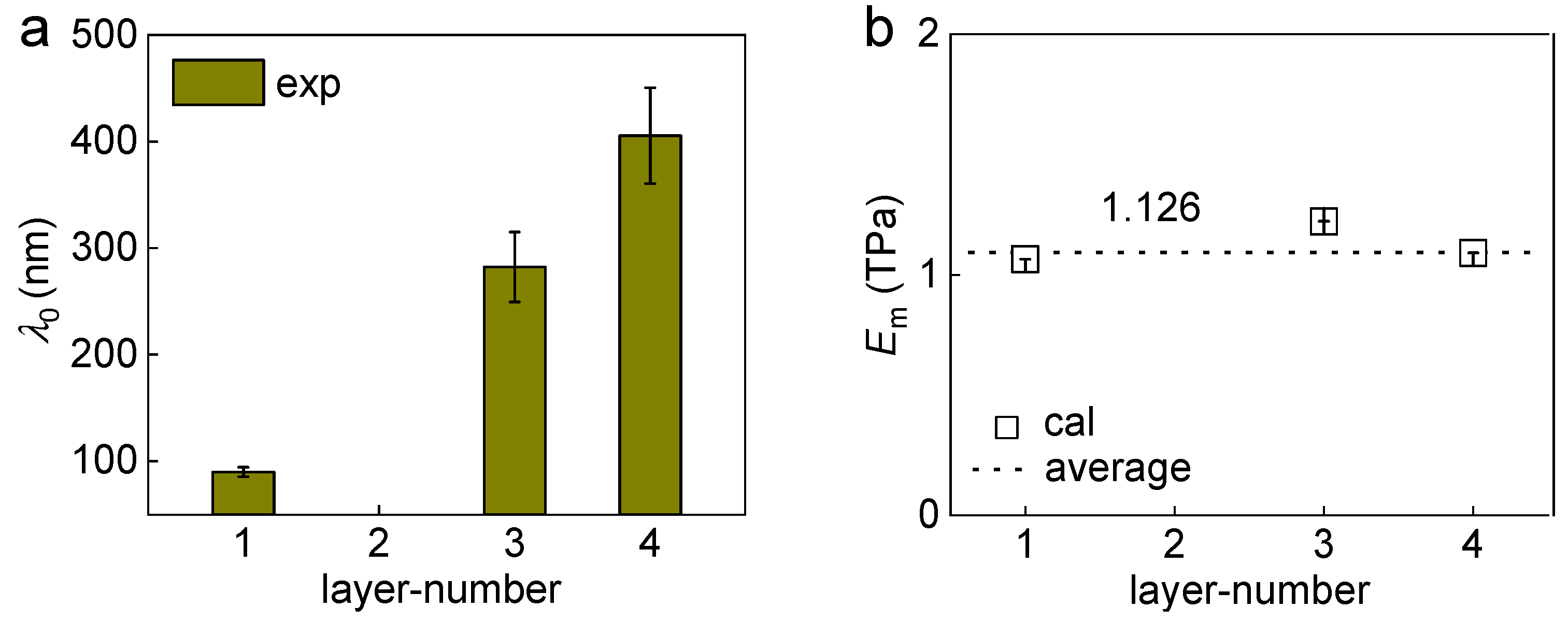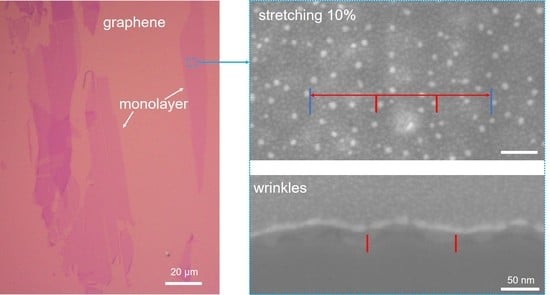Buckling Behavior of Few-Layer Graphene on Soft Substrate
Abstract
:1. Introduction
2. Materials and Methods
3. Results
3.1. Transfer Few-Layer Graphene onto PDMS Film
3.2. Buckling Behavior of Few-Layer Graphene on PDMS Film (Graphene/PDMS)
3.3. Calculation of Young’s Modulus for Graphene with Different Layers
4. Conclusions
Supplementary Materials
Author Contributions
Funding
Institutional Review Board Statement
Informed Consent Statement
Data Availability Statement
Conflicts of Interest
References
- Novoselov, K.S.; Geim, A.K.; Morozov, S.V.; Jiang, D.; Zhang, Y.; Dubonos, S.V.; Grigorieva, I.V.; Firsov, A.A. Electric field effect in atomically thin carbon films. Science 2004, 306, 666–669. [Google Scholar] [CrossRef] [PubMed] [Green Version]
- Georgakilas, V.; Otyepka, M.; Bourlinos, A.B.; Chandra, V.; Kim, N.; Kemp, K.C.; Hobza, P.; Zboril, R.; Kim, K.S. Functionalization of graphene: Covalent and non-covalent approaches, derivatives and applications. Chem. Rev. 2012, 112, 6156–6214. [Google Scholar] [CrossRef] [PubMed]
- Tang, X.; Yang, W.; Yin, S.; Tai, G.; Su, M.; Yang, J.; Shi, H.; Wei, D.; Yang, J. Controllable Graphene Wrinkle for a High-Performance Flexible Pressure Sensor. ACS Appl. Mater. Interfaces 2021, 13, 20448–20458. [Google Scholar] [CrossRef] [PubMed]
- Chung, J.W.; Ko, Y.H.; Hong, Y.K.; Song, W.; Jung, C.; Tang, H.; Lee, J.; Lee, M.h.; Lee, B.-l.; Park, J.-i.; et al. Flexible nano-hybrid inverter based on inkjet-printed organic and 2D multilayer MoS2 thin film transistor. Org. Electron. 2014, 15, 3038–3042. [Google Scholar] [CrossRef]
- Ma, Y.; Zhang, Y.; Cai, S.; Han, Z.; Liu, X.; Wang, F.; Cao, Y.; Wang, Z.; Li, H.; Chen, Y.; et al. Flexible Hybrid Electronics for Digital Healthcare. Adv. Mater. 2020, 32, e1902062. [Google Scholar] [CrossRef]
- Khang, D.Y.; Jiang, H.Q.; Huang, Y.; Rogers, J.A. A stretchable form of single-crystal silicon for high-performance electronics on rubber substrates. Science 2006, 311, 208–212. [Google Scholar] [CrossRef] [Green Version]
- Liu, Z.; Gong, Y.; Zhou, W.; Ma, L.; Yu, J.; Idrobo, J.C.; Jung, J.; MacDonald, A.H.; Vajtai, R.; Lou, J.; et al. Ultrathin high-temperature oxidation-resistant coatings of hexagonal boron nitride. Nat. Commun. 2013, 4, 2541. [Google Scholar] [CrossRef] [Green Version]
- Wang, C.; Liu, Y.; Lan, L.; Tan, H. Graphene wrinkling: Formation, evolution and collapse. Nanoscale 2013, 5, 4454–4461. [Google Scholar] [CrossRef]
- Alden, J.S.; Tsen, A.W.; Huang, P.Y.; Hovden, R.; Brown, L.; Park, J.; Muller, D.A.; McEuen, P.L. Strain solitons and topological defects in bilayer graphene. Proc. Natl. Acad. Sci. USA 2013, 110, 11256–11260. [Google Scholar] [CrossRef] [Green Version]
- Wang, L.; Liu, X.; Zang, J. Mechanically tunable terahertz graphene plasmonics using soft metasurface. 2D Mater. 2016, 3, 041007. [Google Scholar] [CrossRef]
- Meng, L.; Su, Y.; Geng, D.; Yu, G.; Liu, Y.; Dou, R.-F.; Nie, J.-C.; He, L. Hierarchy of graphene wrinkles induced by thermal strain engineering. Appl. Phys. Lett. 2013, 103, 251610. [Google Scholar] [CrossRef] [Green Version]
- Sampathkumar, K.; Androulidakis, C.; Koukaras, E.N.; Rahova, J.; Drogowska, K.; Kalbac, M.; Vetushka, A.; Fejfar, A.; Galiotis, C.; Frank, O. Sculpturing graphene wrinkle patterns into compliant substrates. Carbon 2019, 146, 772–778. [Google Scholar] [CrossRef]
- Androulidakis, C.; Koukaras, E.N.; Sampathkumar, K.; Rahova, J.; Galiotis, C.; Frank, O. Hierarchy of nanoscale graphene wrinkles on compliant substrate: Theory and experiment. Extreme Mech. Lett. 2020, 40, 100948. [Google Scholar] [CrossRef]
- Lee, W.K.; Kang, J.; Chen, K.S.; Engel, C.J.; Jung, W.B.; Rhee, D.; Hersam, M.C.; Odom, T.W. Multiscale, Hierarchical Patterning of Graphene by Conformal Wrinkling. Nano Lett. 2016, 16, 7121–7127. [Google Scholar] [CrossRef] [PubMed]
- Wang, W.; Yang, S.; Wang, A. Strain induced highly oriented graphene wrinkles. Mater. Res. Express 2017, 4, 075601. [Google Scholar] [CrossRef]
- Wang, C.; Lan, L.; Tan, H. The physics of wrinkling in graphene membranes under local tension. Phys. Chem. Chem. Phys. 2013, 15, 2764–2773. [Google Scholar] [CrossRef] [PubMed]
- Huang, M.Y.; Yan, H.G.; Chen, C.Y.; Song, D.H.; Heinz, T.F.; Hone, J. Phonon softening and crystallographic orientation of strained graphene studied by Raman spectroscopy. Proc. Natl. Acad. Sci. USA 2009, 106, 7304–7308. [Google Scholar] [CrossRef] [Green Version]
- Meng, Y.; Zhang, S.; Wu, K.; Li, J.; Li, L. Mechanically Tunable Bilayer Composite Grating for Unique Light Manipulation and Information Storage. Adv. Opt. Mater. 2019, 7, 1801017. [Google Scholar] [CrossRef]
- Meng, Y.; Gong, X.; Huang, Y.; Li, L. Mechanically tunable opacity effect in transparent bilayer film: Accurate interpretation and rational applications. Appl. Mater. Today 2019, 16, 474–481. [Google Scholar] [CrossRef]
- Cairney, J.M.; Munroe, P.R.; Hoffman, M. The application of focused ion beam technology to the characterization of coatings. Surf. Coat. Technol. 2005, 198, 165–168. [Google Scholar] [CrossRef]
- Lee, J.; Lee, H.; Jeong, N.; Park, D.; Choi, I.; Chung, H. High-speed residue-free transfer of two-dimensional materials using PDMS stamp and water infiltration. Curr. Appl. Phys. 2020, 20, 1190–1194. [Google Scholar] [CrossRef]
- Zhuo, L.; Zhang, Y. The mode-coupling of a stiff film/compliant substrate system in the post-buckling range. Int. J. Solids Struct. 2015, 53, 28–37. [Google Scholar] [CrossRef]
- Meng, Y.; Xiang, H.; Zhang, J.; Hu, Z.; Yin, J.; Li, L.; Zhang, Z.; Guo, W. Quantized buckling evolution routes and fracture in stiff/soft bilayer films. Res. Sq. 2021, 2. [Google Scholar] [CrossRef]
- Vandeparre, H.; Damman, P. Wrinkling of stimuloresponsive surfaces: Mechanical instability coupled to diffusion. Phys. Rev. Lett. 2008, 101, 124301. [Google Scholar] [CrossRef] [PubMed] [Green Version]
- Cerda, E.; Mahadevan, L. Geometry and physics of wrinkling. Phys. Rev. Lett. 2003, 90, 074302. [Google Scholar] [CrossRef] [Green Version]
- Vandeparre, H.; Leopoldes, J.; Poulard, C.; Desprez, S.; Derue, G.; Gay, C.; Damman, P. Slippery or sticky boundary conditions: Control of wrinkling in metal-capped thin polymer films by selective adhesion to substrates. Phys. Rev. Lett. 2007, 99, 188302. [Google Scholar] [CrossRef]
- Huang, Z.Y.; Hong, W.; Suo, Z. Nonlinear analyses of wrinkles in a film bonded to a compliant substrate. J. Mech. Phys. Solids 2005, 53, 2101–2118. [Google Scholar] [CrossRef]
- Kabir, H.; Aghdam, M.M. A robust Bézier based solution for nonlinear vibration and post-buckling of random checkerboard graphene nano-platelets reinforced composite beams. Compos. Struct. 2019, 212, 184–198. [Google Scholar] [CrossRef]
- Li, S.; Sitnikova, E.; Liang, Y.; Kaddour, A.-S. The Tsai-Wu failure criterion rationalised in the context of UD composites. Compos. Part A Appl. Sci. Manuf. 2017, 102, 207–217. [Google Scholar] [CrossRef]



| Film | Young’s Modulus (GPa) | Poisson’s Ratio |
|---|---|---|
| PDMS | 0.0018 | 0.48 |
| PMMA | 2 | 0.3 |
| Graphene [11] | 1000 | 0.165 |
Publisher’s Note: MDPI stays neutral with regard to jurisdictional claims in published maps and institutional affiliations. |
© 2022 by the authors. Licensee MDPI, Basel, Switzerland. This article is an open access article distributed under the terms and conditions of the Creative Commons Attribution (CC BY) license (https://creativecommons.org/licenses/by/4.0/).
Share and Cite
Meng, Y.; Li, B.; Li, L.; Zhang, J. Buckling Behavior of Few-Layer Graphene on Soft Substrate. Coatings 2022, 12, 1983. https://doi.org/10.3390/coatings12121983
Meng Y, Li B, Li L, Zhang J. Buckling Behavior of Few-Layer Graphene on Soft Substrate. Coatings. 2022; 12(12):1983. https://doi.org/10.3390/coatings12121983
Chicago/Turabian StyleMeng, Yancheng, Baowen Li, Luxian Li, and Jianqiang Zhang. 2022. "Buckling Behavior of Few-Layer Graphene on Soft Substrate" Coatings 12, no. 12: 1983. https://doi.org/10.3390/coatings12121983






